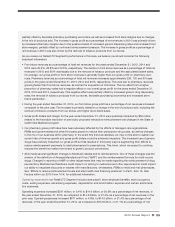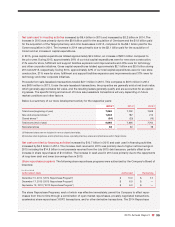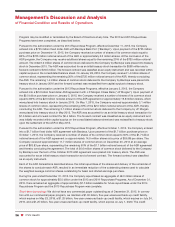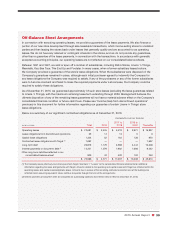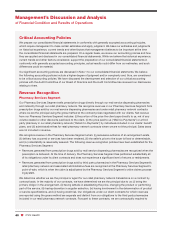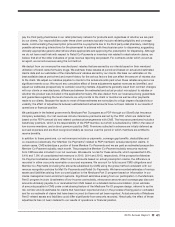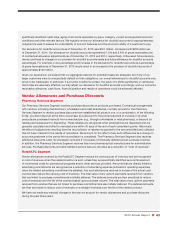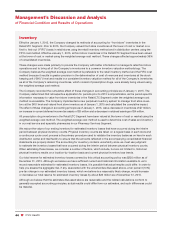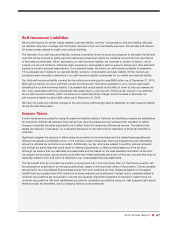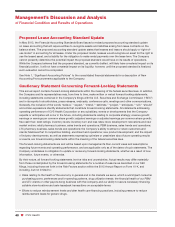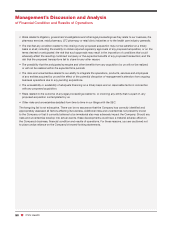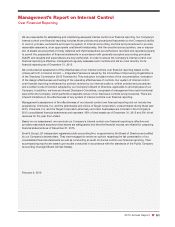CVS 2015 Annual Report Download - page 44
Download and view the complete annual report
Please find page 44 of the 2015 CVS annual report below. You can navigate through the pages in the report by either clicking on the pages listed below, or by using the keyword search tool below to find specific information within the annual report.
Management’s Discussion and Analysis
of Financial Condition and Results of Operations
42 CVS Health
Retail/LTC Segment
Retail Pharmacy
We recognize revenue from the sale of front store merchandise at the time the merchandise is
purchased by the retail customer and recognize revenue from the sale of prescription drugs when the prescription
is picked up by the customer. Customer returns are not material. Sales taxes are not included in revenue.
Long-term Care
We recognize revenue when products are delivered or services are rendered or provided to
our customers, prices are fixed and determinable, and collection is reasonably assured. A significant portion of
our revenues from sales of pharmaceutical and medical products are reimbursed by the federal Medicare Part D
program and, to a lesser extent, state Medicaid programs. Payments for services rendered to patients covered by
these programs are generally less than billed charges. We monitor our revenues and receivables from these reim-
bursement sources, as well as other third party insurance payors, and record an estimated contractual allowances
for sales and receivable balances at the revenue recognition date, to properly account for anticipated differences
between billed and reimbursed amounts. Accordingly, the total net sales and receivables reported in our consoli-
dated financial statements are recorded at the amount expected to be ultimately received from these payors. Since
billing functions for a portion of our revenue systems are largely computerized, enabling online adjudication at the
time of sale to record net revenues, our exposure in connection with estimating contractual allowance adjustments
is limited primarily to unbilled and initially rejected Medicare, Medicaid and third party claims (typically approved
for reimbursement once additional information is provided to the payor). For the remaining portion of our revenue
systems, the contractual allowance is estimated for all billed, unbilled and initially rejected Medicare, Medicaid
and third party claims. We evaluate several criteria in developing the estimated contractual allowances on a monthly
basis, including historical trends based on actual claims paid, current contract and reimbursement terms, and
changes in customer base and payor/product mix. Contractual allowance estimates are adjusted to actual amounts
as cash is received and claims are settled, and the aggregate impact of these resulting adjustments was not
significant to our results of operations. Further, we do not expect the impact of changes in estimates related to
unsettled contractual allowance amounts from Medicare, Medicaid and third party payors as of December 31, 2015
to be significant to our future consolidated results of operation, financial position and cash flows.
Patient co-payments associated with Medicare Part D, certain state Medicaid programs, Medicare Part B and
certain third party payors are typically not collected at the time products are delivered or services are rendered, but
are billed to the individuals as part of our normal billing procedures and subject to our normal accounts receivable
collections procedures.
Health Care Clinics
for services provided by our health care clinics, revenue recognition occurs for completed
services provided to patients, with adjustments taken for third party payor contractual obligations and patient direct
bill historical collection rates.
Loyalty Program
our customer loyalty program, ExtraCare®, is comprised of two components, ExtraSavingsTM
and ExtraBucks® Rewards. ExtraSavings coupons redeemed by customers are recorded as a reduction of revenues
when redeemed. ExtraBucks Rewards are accrued as a charge to cost of revenues when earned, net of estimated
breakage. We determine breakage based on our historical redemption patterns.
Allowances for Doubtful Accounts
Accounts receivable primarily includes amounts due from third party providers (e.g., pharmacy benefit managers,
insurance companies, governmental agencies and long-term care facilities), clients, members and private pay
customers, as well as vendors and manufacturers. We provide a reserve for accounts receivable considered to
be at increased risk of becoming uncollectible by establishing an allowance to reduce the carrying value of such
receivables to their estimated net realizable value. We establish this allowance for doubtful accounts and consider
such factors as historical collection experience, (i.e., payment history and credit losses) and creditworthiness,



